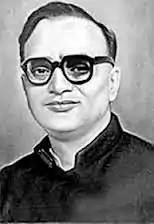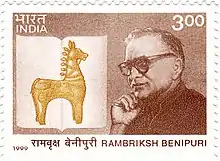Ramavriksha Benipuri | |
|---|---|
 | |
| Born | 23 December 1899 Benipur Village, Muzaffarpur, India |
| Died | 9 September 1968 (aged 68) Muzaffarpur, India |
| Occupation |
|
| Nationality | Indian |
| Literary movement | Kisan Mahasabha, Quit India Movement, Janaue Todo Abhiyaan |
| Notable works | Ambpali, Patiton Ke Desh Mein, Genhu Aur Gulab, Maati Ki Muratien, Zanjeerein Aur Deewarien, Vijeta, Shakuntala etc. |
| Notable awards | Lifetime Achievement Award For Contribution In Literature From Rashtra Bhasha Parishad |
| Children | Dr. Prabha Benipuri |
| Relatives | Shyam Sunder Das |
Ramavriksha Benipuri (ⓘ, 23 December 1899 – 9 September 1968) was a freedom fighter, Socialist Leader editor and Hindi writer. He was born in a small village named Benipur in Muzaffarpur district in a Bhumihar family in the Indian state of Bihar. He had spent nine years in prison for fighting for India's independence.[1] He was the founder of Bihar Socialist Party in 1931 and Congress Socialist Party in 1934. He served as the president of Patna District Congress Committee of Indian National Congress from 1935 to 1937 during the 1937 Indian provincial elections.[2] He was elected as the Member of the Legislative Assembly (India) from Katra North in 1957. In 1958, he was elected as the Syndicate Member of Bihar University (Now Babasaheb Bhimrao Ambedkar Bihar University), Muzaffarpur.
Ramvriksha Benipuri hailed from Muzaffarpur in Bihar and took active part in the Indian freedom movement.[3] He was also a journalist of Hindi Literature and started several newspapers like Yuvak in 1929 and regularly contributed in various others to spread the idea of nationalism and freedom from British rule.[4]
Writing career
Benipuriji's first writing was published in Pratapa of Kanpur in 1916.[5] Since then, till the attainment of Independence of India, his was a life of political activities and struggle.[5] In 1928–29, Benipuri established Yuvaka-Ashram in front of Patna College in Patna with his friends and lifelong colleagues Ganga Sharan Singh and Pandit Ramnandan Mishra.[5] In 1929, Benipuri started the publication of Yuvaka, a Hindi monthly from this organization, under his editorship.[5]
Benipuri started his literary career in 1921 with a weekly Hindi journal Tarun Bharat of which he was an associate editor. He also worked as an associate editor of the Kisan Mitra weekly in 1922, Golmal in 1924 and as an editor of the monthly journal Balak in 1926, but the publication of Yuvak made him more popular.[6]
Yuvak Hindi Journal
Yuvak, an illustrated Hindi monthly magazine, was launched in January 1929 by Rambriksh Benipuri, a distinguished Hindi writer, critic, poet, journalist and freedom fighter.[6] He was assisted by Ganga Sharan Singh (Sinha), Ambica Kant Sinha and Jagdish Narayan in its publication.[6] Devoted to 'strength, courage and culture', Yuvak was edited, printed and published by Rambriksh Benipuri from the Patna Yuvak Ashram.[6] It was printed at the Searchlight Press.[6] Yuvak was the official organ of the Patna Yuvak Sangh founded in 1927 by Manindra Narayan Roy, a journalist of The Searchlight.[6]
Yuvak made Benipuri an eyesore of the colonial British government as its mission was to secure Swaraj for India promoting armed revolution and overthrowing the British regime.[6] Its writings had a clear impact of Marxism as its contributors were political elites, avowed nationalists and Marxist revolutionaries.[6]
As a Playwright
Ramvriksha Benipuri stands in a class apart as a playwright.[7] He wrote Ambapalai during his detention in the Hazaribagh Central Jail.[7] Later on he wrote a series of one-act plays and radio-dramas, more notable being: the Netra-dan, Tathagat, Sanghamitra, Singhal Vijay and Vijeta.[7] Benipuri had a forceful pen and was a prolific writer.[7] Main attraction of Benipuri's plays lies in his way of writing.[7] There is a delightful mixture of romanticism and idealism in his plays.[7]
Short stories
In most of Ramvriksha Benipuri's short stories pictures of rural life of north Bihar, specially that of Muzaffarpur district have been vividly presented.[7] His Mati ki Mooraten, though not a story book in strict sense of the term, actually presents persons of flesh and blood, each throbbing with life, on a rural canvas.[7]
Style and influence
Benipuri wrote mostly big stories and essays. His dramas covered mostly ancient events. For example, Amipure depicts the life of the famous courtesan Ambipure who adopted and converted to Buddhism after meeting Buddha. Likewise Netradaan (that is, Gift of Eyes), another drama, is based on a historical legend involving Ashoka and his son Kunal.
He was also a distinguished playwright.[1]
A stanza from one of his famous poems, "Shahido – tumhari yaad me" goes like this:
"Hey, the Martyrs of August Revolution,
We shall forever keep the flag high
For which thy hath given the lives;
We shall always esteem the path of martyrdom
Sanctified by the blood of the supreme sacrifice."
The eminent Hindi writer, poet, play-wright, journalist and nationalist Rambriksh Benipuri, who spent more than eight years in prison fighting for India's independence writes of Non-co-operation movement as:[9]
When I recall Non-Cooperation era of 1921, the image of a storm confronts my eyes. From the time I became aware, I have witnessed numerous movements, however, I can assert that no other movement upturned the foundations of Indian society to the extent that the Non-Cooperation movement did. from the most humble huts to the high places, from villages to cities, everywhere there was a ferment, a loud echo.

In the freedom movement
Benipuri was a close associate of Jayaprakash Narayan and a leading light of the Congress Socialist Party.[6] He took active part in the agitation against the Rowlatt Act and participated in the Non-cooperation movement launched by Mahatma Gandhi in 1920.[6] He was an active member of the Bihar Pradesh Congress Committee, a member of the Indian National Congress, one of the founder members of the Bihar Socialist Party and a member of the working committee of the All India Congress Socialist Party.[6] He had also been the President of the Bihar Provincial Kisan Sabha and the Vice-President of the All India Kisan Sabha.[6] At the 50th session of the All India Congress Committee held at Faizpur in 1937 he moved a resolution on the abolition of Zamindari.[6] Again, it was Benipuri who helped Jayaprakash Narayan escape from the Hazaribagh Central Jail along with Jogendra Shukul, Suraj Narayan Singh, Gulali Sonar, Pandit Ramnandan Mishra, and Shaligram Singh on 9 November 1942 keeping the prisoners engaged in Diwali Celebration.[6]
In Hazaribagh Central Jail, he initiated a campaign " Janaeu Todo Abhiyaan" (Breaking of the Upanayana threads) against Casteism. As Upnayan threads are the symbol of upper castes epesically Brahmin and Zamindar.
Homage

In 1999, Benipuri was one of the Hindi writers depicted in a set of commemorative postal stamps released to celebrate the "Linguistic Harmony of India," marking the 50th anniversary since India adopted Hindi as its official language.[10]
Centenary celebrations
The chief guest on the occasion of the birth centenary of Benipuri held in zonal railway training centre at Muzaffarpur, held under the auspices of railway ministry, was the former Prime Minister of India Chandra Shekhar.[11] The main speakers included litterateur Namwar Singh and journalist Prabhash Joshi.[11] Namwar Singh described Benipuri as only the second litterateur who preferred to associate his name with that of his village.[11]
Prabhash Joshi ranked Benipuri with Makhanlal Chaturvedi and Ganesh Shankar Vidyarthi, who were both contemporary writers and journalists as well.[11] He said '"Benipuri was not like today's journalists who work only to earn. Benipuri had a desire to create a "samtawadi samaj" and fight against imperialism."[11]
Major literary works
Memoirs and essays
- Patiton Ke Desh Mein-1930-33
- Chita Ke Phool-1930-32
- Lal Taaraa-1937-39
Lal Tara is the symbol of a new light of the morning.[5] The light is very near and therefore the darkness has increased.[5] The writer wants to say that the darkness would disappear within a short time and a new rising light would come out.[5] There are 16 such sketches in the collection.[5] Benipuri tries to search out a new society, a new way of living and a new culture.[5]
- Kaidee Ki Patni-1940
- Maate
-1941-45
- Gehun Aur Gulaab- 1948–50
It was published in 1950.[5] This composition also brought much laurels and fame to Benipuri and was welcomed in the Hindi world like the former two titles, "Lal Tara" and "Mati ki Murten".[5]
- Zanjeeren Aur Deewaren
- Udate Chalo, Udate Chalo
Dramas
- Ambpali-1941-46
- Sita Ki maan-1948-50
- Sanghamitra-1948-50
- Amar Jyoti-1951
- Tathaagat
- Singhal Vijay
- Shakuntala
- Ramrajya
- Netradaan-1948-50
- Gaao Ke Devata
- Nayaa samaaj
- Vijeta-1953.
- Baiju Mama, National Book Trust, 1994
Editing and critical
- Vidyapati Ki Padaavali
- Bihari (poet) satsai Ki Subodh Teekaa
Biography
- Jayaprakash Narayan only with the initials Jayaprakash
Lalit Gadya
- Vande Vaani Vinayaka −1953-54.
Collected works
- Collected Works of Rambriksh Benipuri, 8 volumes, Radhakrishna Prakashan
Selected works/anthology
- Rambriksh Benipuri Rachna Sanchayan, Sahitya Akademi
Works on Rambriksha Benipuri
- Gajanan Pandurang Chavan, Ramvriksha aur unka sahitya, 1984.
- Dr. Prabha Benipuri, Benipuriji ke natakon me samajik chetna, 1989.
- Ram Bachan Rai, Ramvriksh Benipuri, Sahitya Akademi, 1995, ISBN 81-7201-974-2.
- Raśmi Caturvedī, Rāmavr̥ksha Benīpurī ke rekhācitra, eka adhyayana, Sāhitya Nilaya, 2005.
- Indu Prakash Pandey, Hindi Literature: Trends & Traits, Firma K. L. Mukhopadhyay, 1975.
See also
References
- 1 2 Rai, Ram Bachan (1995). Ramvriksh Benipuri. Sahitya Akademi. p. 66. ISBN 81-7201-974-2.
- ↑ कुछ मैं कुछ वें. New Delhi: Anamika Publishers And Distributors Pvt Ltd. ISBN 9788179755198.
- ↑ "Special Postage Stamps on Linguistic Harmony of India". Latest PIB Releases. Press Information Bureau of the Government of India. September 1999. Retrieved 26 September 2008.
- ↑ Das, Sisir Kumar (2006). A History of Indian Literature. Sahitya Akademi. ISBN 978-81-7201-798-9.
- 1 2 3 4 5 6 7 8 9 10 11 Jha, Sureshwar. Gems of Mithila (2014 ed.). Mithila Sanskrit Post Graduate Study & research Institute (Publication Director – Dev Narain Yadav). pp. 241–249. OCLC 895247051.
- 1 2 3 4 5 6 7 8 9 10 11 12 13 14 Srivastava, N.M.P. (2015). Anguish, Protest and Surcharged Nationalism: A Study of the Proscribed Literature in Colonial Bihar (1912–47) (2015 ed.). Directorate of Bihar State Archives, Government of Bihar, Patna. pp. 378–79. ISBN 978-93-81456-36-1.
- 1 2 3 4 5 6 7 8 Datta, Kali Kinkar (ed.). The Comprehensive History of Bihar Volume – III, Part – II (1976 ed.). Kashi Prasad Jayaswal Research Institute, Patna. pp. 511–512. ISBN 81-89785-02-8.
- ↑ Niyogi, Sumanta (2010). Essays on Modern History (7.The 1942 Movement in Bihar – A stanza from the Hindi poem, "Shahido – tumhari yaad me", composed by Ramvriksha Benipuri, the eminent Hindi poet, and an active participant in the 1942 movement, published in the Dainik Janata, Patna, 9th August 1951; translated into English by the author.). Janaki Prakashan. ISBN 978-81-907634-5-5.
- ↑ Biswamoy Pati, Lata Singh, ed. (2014). Colonial and Contemporary Bihar and Jharkhand (Chapter 7. Lata Singh, Nationalism in Bihar, 1921–22: Mapping Resistances quoting Suresh Sharma (ed.) Benipuri Granthavali, vol. IV, 1998, p.38). Primus Books. p. 264 (at p. 127). ISBN 978-93-80607-92-4.
- ↑ "Special Postage Stamps on Linguistic Harmony of India". Latest PIB Releases. Press Information Bureau of the Government of India. September 1989. Retrieved 4 May 2008.
- 1 2 3 4 5 "Dictatorship threatening Indian democracy: Chandrashekhar". The Times of India. 20 December 2001. Retrieved 3 April 2009.